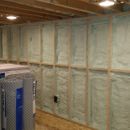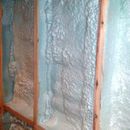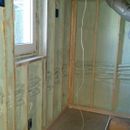Basement flash-and-batt dewpoint
Hello all,
We are in the midst of finishing our basement and I’m debating whether to add batt insulation to the closed-cell spray foam we already got. The walls are 2×4 framed and were placed about 1.5″ off the concrete. We then had spray foam installed to R-14 on the walls and R-20 at the rim joist area. The R-14 on the walls left about 2.5″ depth in the cavity that could be filled with batt insulation. The property slopes towards the back of the house, so the back wall is half above grade while the front is mostly below grade.
I was hoping to fill the rest of the walls with rockwool batt to get to a total r-value of R-28 or so (hard to tell because the batts will be compressed) and to r-42 (5.5″ thick batts) in the header space, but I’m a bit concerned about the dew point landing on the warm side of the spray foam.
I did the dew point calculation using the advice from Joe in this article
https://www.greenbuildingadvisor.com/article/are-dew-point-calculations-really-necessary
and I also used the CCHRC calculator here for the dewpoint:
http://www.cchrc.org/calculators
I live in Ottawa, Canada so our winters can get pretty cold. Averaging the temperatures of the three coldest months over the last 5 years, gives a design temperature of about 16 deg F. We usually keep our humidity levels at about about 30% so with these figures, the calculator suggests that we should have just enough foam (dewpoint is 37.2 deg F and the inner surface of the foam would be at 43 deg on the walls and 44 in the rim joist space). But on the coldest days (days with -15 deg F lows and 5 deg highs are common and sometime lasts for a week) we could well have condensation forming on the face of the spray foam on the above grade sections of all and in the rim joist.
Should I be worried about this from a durability perspective? The foam and rockwool aren’t harmed by moisture but the drywall and wood framing wouldn’t fare so well. One of the challenges is that I can’t get different thicknesses of rockwool – we only have 3.5″ and 5.5″ but I only really need about 2″ for the walls. If I compress it in, I’ll get something less than the advertised R-14 for a 3.5″ batt but it’s an unknown given the uneven thickness of the foam. Can comfort board be cut to fit in cavities?
I’ve attached a few pictures for reference.
Hoping for some suggestions on how to go about this to give a robust wall assembly.
Thanks in advance for any advice.
-Patrick
GBA Detail Library
A collection of one thousand construction details organized by climate and house part













Replies
Pattric,
Moisture damage is about long term water buildup. Since most of the basement is bellow grade, the small section above that will accumulate a small amount of moisture during the coldest of days, but it will quickly dry once those pass. Concrete is also a good heat conductor, your above grade walls stay warmer than outdoor temperature.
With 2" gap you only have room for R8, which will sill give you well over 35% you need for walls in zone 6. Even if you bump that up to R14, you still have a good margin.
If you want 2" insulation, look for Rockwool AFB (stock item at commercial drywall suppliers). It is meant for metal studs, so you have to do a bit of trimming to fit it between wood. Might be simpler to strap out your wall so it can fit the 3.5" comfortbatt though.
Thanks Akos! After you mentioned 35%, I wondered where that came from and then saw this:
https://www.buildingscience.com/documents/building-science-insights/bsi-100-hybrid-assemblies?utm_source=Building+Science+Corporation+List&utm_campaign=d8164f923c-BSC+Newsletter+Issue+%23101&utm_medium=email&utm_term=0_194890bc8c-d8164f923c-63891105
Based on the article, my 50/50 assembly is okay even in zone 8 so I should be fine.
I looked into the rockwool AFB. It doesn't seem to be widely available...probably need to look at specialized vendors as you suggest. I think I might just saw the rockwool flush with the studs after putting it in. This will waste a bit of material but it's probably the most accessible option for me. I can also use the waste material for fire blocking that I need to do in a few spots (needs to be packed tight anyway).